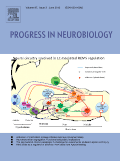
GENES BRAIN AND BEHAVIOR
Scope & Guideline
Advancing Insights into Genetic Influences on Behavior
Introduction
Aims and Scopes
- Genetic and Neurobiological Interactions:
The journal emphasizes studies that investigate how genetic variations influence neurobiological processes and behavioral outcomes, often utilizing animal models to dissect these relationships. - Behavioral Phenotyping:
Research often involves behavioral phenotyping, where researchers assess the impact of genetic and environmental factors on behavior, including anxiety, depression, addiction, and social interactions. - Translational Research:
'Genes, Brain and Behavior' aims to bridge the gap between basic research and clinical applications, focusing on how findings from animal studies can inform our understanding of human neuropsychiatric disorders. - Multi-Omics Approaches:
The journal supports the use of multi-omics techniques, such as genomics, transcriptomics, and proteomics, to provide comprehensive insights into the biological underpinnings of behavior. - Neurodevelopmental Disorders:
A significant focus is placed on neurodevelopmental disorders, including autism spectrum disorders and ADHD, exploring genetic and environmental contributions.
Trending and Emerging
- Integrative Genomics and Behavioral Analysis:
An increasing number of studies combine genomic data with behavioral analysis, focusing on how genetic variants influence complex behaviors across different environmental contexts. - Microbiome and Behavior Interactions:
Recent publications show a rising interest in how gut microbiota affect neurological functions and behaviors, particularly in relation to stress, anxiety, and seizure disorders. - Sex Differences in Behavior and Genetics:
There is a notable trend towards exploring sex differences in behavioral and genetic responses, reflecting a deeper understanding of how biological sex influences neurological and psychological outcomes. - Machine Learning and Data-Driven Approaches:
Emerging methodologies utilizing machine learning for data analysis in behavioral genetics are increasingly being adopted, offering new insights into complex data sets and phenotypic outcomes. - Environmental Influences on Genetic Expression:
Research is increasingly focused on how environmental factors, such as early life experiences or social contexts, interact with genetic predispositions to shape behavior.
Declining or Waning
- Traditional Behavioral Assays:
There appears to be a declining focus on traditional behavioral assays that do not incorporate modern genetic or neurobiological insights, as researchers lean towards more integrative approaches. - Species-Specific Studies:
Research focusing solely on specific species without broader implications or comparisons to other models is becoming less common, possibly due to the increasing demand for findings that have translational relevance to human disorders. - Neuropharmacology without Genetic Context:
Studies that examine neuropharmacological effects in isolation, without considering genetic predispositions or interactions, have seen a reduction, as the field moves towards understanding these effects in a holistic manner.
Similar Journals

NEUROSCIENCE AND BIOBEHAVIORAL REVIEWS
Pioneering insights into behavioral and cognitive neuroscience.NEUROSCIENCE AND BIOBEHAVIORAL REVIEWS, published by PERGAMON-ELSEVIER SCIENCE LTD in the United Kingdom, serves as a leading interdisciplinary platform for the dissemination of pioneering research and reviews in the realms of Neuroscience, Behavioral Neuroscience, Cognitive Neuroscience, and Neuropsychology. With an impressive impact factor reflected in its Q1 ranking across multiple categories for 2023, the journal is recognized for its rigorous peer-reviewed content that influences the advancement of scientific knowledge in behavioral and cognitive research. An essential resource for researchers, professionals, and students alike, the journal emphasizes the exploration of complex neural mechanisms that underlie behavior and cognitive processes. Despite being a subscription-based publication, the journal's extensive archive from 1978 to 2024 fosters a wealth of knowledge designed to inspire and facilitate future advancements within the field.

BRAIN BEHAVIOR AND IMMUNITY
Advancing Insights into Behavior and Immunity.BRAIN BEHAVIOR AND IMMUNITY is a premier academic journal published by ACADEMIC PRESS INC ELSEVIER SCIENCE, focusing on the intricate relationships between the nervous and immune systems. With an impressive impact factor and consistent ranking in the top quartile (Q1) across several categories such as Behavioral Neuroscience, Endocrine and Autonomic Systems, and Immunology, this journal stands out as a critical resource for researchers and professionals in these rapidly evolving fields. Since its inception in 1987, the journal has committed to publishing high-quality, peer-reviewed research that advances our understanding of immunological processes as they relate to behavior and mental health. Though it does not currently offer Open Access, it is widely accessible to institutional libraries and professionals, ensuring that groundbreaking research reaches a broad audience. As the field continues to expand, BRAIN BEHAVIOR AND IMMUNITY remains a vital platform for innovative studies and reviews that bridge the gap between neuroscience and immunology, making it an essential read for academics, clinicians, and students dedicated to furthering research in this interdisciplinary domain.

JOURNAL OF NEUROSCIENCE METHODS
Innovating the Future of Neuroscience MethodologiesWelcome to the JOURNAL OF NEUROSCIENCE METHODS, a prestigious platform for disseminating innovative methodologies in the interdisciplinary field of neuroscience. Published by Elsevier, this journal has been pivotal since its inception in 1979, covering a diverse range of experimental techniques and methods aimed at advancing our understanding of neural systems and functions. With a commendable impact factor and classified within the Q2 category in Neuroscience (miscellaneous) as of 2023, the journal continues to attract high-quality research from professionals, scholars, and students alike. While maintaining a robust subscription model, it provides unparalleled access to groundbreaking studies, fostering collaboration and knowledge exchange among the global neuroscience community. Join us as we explore and contribute to the evolution of neuroscience methodologies through rigorous research and comprehensive reviews, setting the stage for future discoveries.

Biological Psychiatry-Cognitive Neuroscience and Neuroimaging
Decoding Mental Health: Where Science Meets InsightBiological Psychiatry-Cognitive Neuroscience and Neuroimaging is a leading interdisciplinary journal published by Elsevier, focusing on the convergence of biological psychiatry, cognitive neuroscience, and advanced neuroimaging techniques. With its prestigious Q1 rankings across essential categories such as Biological Psychiatry, Cognitive Neuroscience, and Neurology (clinical), this journal is at the forefront of research that examines the complexities of mental health through innovative methodologies. Covering a broad spectrum of topics from neurobiological mechanisms to clinical applications, it aims to provide a platform for scholars and practitioners to exchange insights on mental disorders and their neurobiological underpinnings. The impact factor and Scopus rankings further underscore its importance, with rankings highlighting its position in the top percentiles of related disciplines. By fostering an open exchange of ideas and promoting cutting-edge research, this journal is an essential resource for researchers, professionals, and students dedicated to advancements in the understanding and treatment of psychiatric and neurological conditions.

Brain and Behavior
Connecting Minds: Where Neuroscience Meets Behavior.Brain and Behavior is a premier open-access journal published by WILEY, dedicated to advancing the field of Behavioral Neuroscience. With its ISSN 2162-3279, the journal has established itself as a vital resource for researchers, professionals, and students alike, fostering the dissemination of cutting-edge research since its inception in 2011. Renowned for its rigorous peer-review process, it enjoys a commendable Q2 ranking within the field, reflecting its impactful contributions and relevance in the scientific community. The journal not only emphasizes innovative studies that bridge behavioral science and neuroscience but also serves as a platform for diverse methodologies and interdisciplinary approaches. Accessible [open access](https://onlinelibrary.wiley.com/journal/21623279), Brain and Behavior invites submissions that explore the neural mechanisms underlying behavior, aiming to engage a global audience eager to expand the boundaries of knowledge in this dynamic field. Positioned in the heart of the United States, at 111 River St, Hoboken, NJ, it is strategically placed to collaborate with leading institutions and researchers worldwide.

INTERNATIONAL JOURNAL OF DEVELOPMENTAL NEUROSCIENCE
Advancing the Frontiers of Developmental NeuroscienceThe INTERNATIONAL JOURNAL OF DEVELOPMENTAL NEUROSCIENCE is a critical platform for disseminating cutting-edge research in the field of developmental biology and neuroscience. Published by WILEY, this esteemed journal has been contributing to the academic community since its inception in 1983, and continues to serve as a vital resource through to 2024. With an impact factor that reflects its influence in the field—ranking in Q3 for both Developmental Biology and Developmental Neuroscience—this journal presents an opportunity for researchers, professionals, and students alike to engage with pioneering studies and extend their understanding of complex developmental processes. Although not open access, the journal provides an essential repository of knowledge for those seeking to explore the nuances of neurological development and related disciplines. It actively supports academic discourse and research dissemination, thereby playing a significant role in advancing our collective understanding of developmental neuroscience.

PROGRESS IN NEUROBIOLOGY
Advancing the Frontiers of NeurosciencePROGRESS IN NEUROBIOLOGY is a prestigious journal dedicated to advancing the field of neuroscience, published by Pergamon-Elsevier Science Ltd. With an impressive impact factor, it stands as a critical resource for researchers, professionals, and students alike, featuring rigorous peer-reviewed articles that explore the latest developments in neurobiology. The journal has established itself as a leading publication, ranked in the Q1 category for Neuroscience (miscellaneous) and holding a notable 13/113 rank in General Neuroscience per Scopus metrics, placing it in the top 12% of its field. Since its inception in 1959, PROGRESS IN NEUROBIOLOGY has covered a wide array of topics, from molecular mechanisms to cognitive processes, fostering a comprehensive understanding of brain functions. While the journal is not open access, it ensures accessibility to profound knowledge through institutional subscriptions. Researchers and scholars will find critical analyses and innovative research that are pivotal for both foundational knowledge and cutting-edge investigations in the neuroscience realm.

Frontiers in Behavioral Neuroscience
Exploring the Neural Roots of Behavior.Frontiers in Behavioral Neuroscience is a distinguished journal published by FRONTIERS MEDIA SA, specializing in the intricate relationship between behavior and the underlying neural processes. Established in 2007, this Open Access journal, based in Switzerland, aims to disseminate high-quality, peer-reviewed research that spans both Behavioral and Cognitive Neuroscience, as well as Neuropsychology and Physiological Psychology. With an impressive ranking in the top quartiles of these categories—Q2 in Behavioral and Cognitive Neuroscience and Q1 in Neuropsychology—this journal plays a pivotal role in advancing the understanding of complex behavioral phenomena through a neuroscientific lens. The journal's commitment to open accessibility ensures that groundbreaking findings are available to a wide audience, facilitating collaboration and innovation within the scientific community. As the field continues to evolve, Frontiers in Behavioral Neuroscience remains at the forefront, supporting researchers, professionals, and students alike in their pursuit of knowledge and understanding in this dynamic discipline.

Molecular Autism
Bridging disciplines to illuminate autism's complexities.Molecular Autism, published by BMC in the United Kingdom, is a premier open-access journal dedicated to publishing high-quality research on the molecular and genetic factors contributing to autism spectrum disorders. Since its inception in 2010, the journal has established itself as a vital resource for researchers and clinicians, offering insights into the developmental biology, neuroscience, and psychiatric dimensions of autism. With an impressive impact factor and rankings placing it in the Q1 category across multiple relevant fields such as Developmental Biology, Developmental Neuroscience, Molecular Biology, and Psychiatry and Mental Health, it serves as a critical platform for the dissemination of innovative research and interdisciplinary collaboration. The journal encourages open dialogue through its commitment to making research freely accessible, thereby advancing knowledge and fostering advances in the understanding of autism. By bridging diverse disciplines and engaging with cutting-edge research, Molecular Autism aims to enhance our understanding of autism's complexities and inform future therapeutic approaches.

Current Behavioral Neuroscience Reports
Unveiling Insights at the Intersection of Mind and EnvironmentCurrent Behavioral Neuroscience Reports, published by SPRINGERNATURE, stands at the forefront of advancements in the intricate field of behavioral neuroscience. Since its inception in 2014, this journal has steadily garnered attention within academic circles, boasting a commendable ranking among its peers, including a Q3 classification in Behavioral Neuroscience and a Q2 classification in Public Health, Environmental and Occupational Health as of 2023. Although it operates under traditional access models, the journal is committed to disseminating high-quality research that bridges the gap between neuroscience and behavioral studies, appealing to researchers, professionals, and students alike. With a notable E-ISSN of 2196-2979, Current Behavioral Neuroscience Reports facilitates valuable insights that are critical for understanding the underlying mechanisms of behavior and their implications for public health and environmental factors. This journal is essential for those seeking to contribute to a multidisciplinary dialogue that enhances our comprehension of behavioral neuroscience.